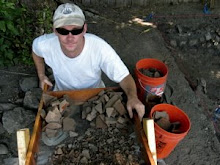Rust is the colloquial term for decayed iron, steel, and other metals. I use "rust" and "corrosion" on this blog because everybody immediately knows what that means, irregardless of how much chemistry one may know. I do want to put a formal explanation of rust because it helps people to understand why we are hopeful for our experiments.
Rusting metal is undergoing an electrochemical reaction. This means that electrical energy is driving chemical changes to the object. While we don't need to go into too much detail about the atomic level, atoms that chemists group as metals share a couple of traits. Metal ions are generally positive, in that they seek additional electrons when they are free or in solution. A chemist would say that metal ions are electron deficient, so that when metal ions bond together into molecules, the group of ions don't have enough elections to form common valence bonds (which tend to be very stable). Instead, metal molecules are held together through metallic bonds. Metallic bonds enable a few electrons to be shared by all atoms, where one election might facilitate bonds between three individual atoms, for example. But while doing this the electrons move around a lot and this movement is what enables electrical current to move through metals.
Corrosion
occurs in metals upon the transfer of electrical charge. A zap of electrical energy pumps a bunch of new electrons into the metal atoms, ionizing them, and allowing them to form new bonds with other atoms that might be in the neighborhood. During ionization, foreign atoms such as oxygen join with
the metallic ions and form covalent bonds. The new substance formed through this process is more stable than the pure metallic material was before the reaction. Most metals exhibit visual changes as a result: silver corrosion appears as
black tarnish, copper corrosion forms a green encrustation, and iron breaks
down into reddish brown rusts.In short, metallic atoms are very unhappy when they are together by themselves. Fe (iron) does not like being with just other Fe atoms, nor does Cu (copper) or Ti (tin). If you pump some electrons into them or simply expose them to other atoms, they will jump at the opportunity to form stable covalent bonds, and once they have done that, it is very hard to reverse that chemical change.
If you leave your bike out in the rain, the steel parts will rust, and you will not be able to convince the iron to let go of it's bond with the oxygen ever again.The chemical change also means that the molecules have taken a new shape, one that is generally larger, so these molecular changes have effects that you can see with your naked eye. Corroded objects swell and warp, discolor, and even change hardness.
There are lots and lots of videos and useful things about this on the Internet, such as these YouTube videos. Why? Because metals are essential to human existence in our environment but the metals don't like staying in the form where we find them useful. Stopping metals from corroding has been a key human endeavour since humans started making metals in the first place!
In the next post, I will explain the decay of iron and related metals (ferrous metals) in more specific terms.
Subscribe to:
Post Comments (Atom)

No comments:
Post a Comment